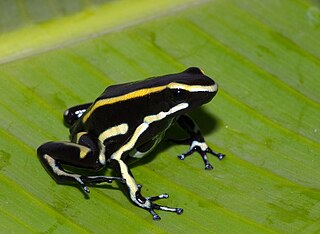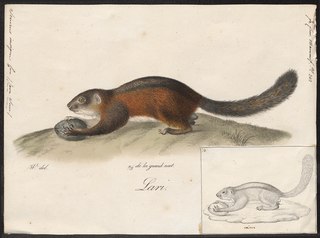
The yellow-striped poison frog is a species of frog in the family Dendrobatidae. It is endemic to Colombia. Its natural habitats are subtropical or tropical dry forests, subtropical or tropical moist lowland forests, subtropical or tropical moist montane forests, intermittent freshwater marshes, and plantations.
Platymantis bimaculatus is a species of frog in the family Ceratobatrachidae. It is endemic to West Papua, Indonesia.

The pink-legged rail, also known as the New Britain rail, is a species of bird in the family Rallidae.
The white-striped forest rail is a species of bird in the family Sarothruridae. It is endemic to West Papua, Indonesia. Its natural habitat is subtropical or tropical moist montane forests. It is threatened by habitat loss.

Hose's langur is a species of primate in the family Cercopithecidae endemic to the island of Borneo, including Brunei, Kalimantan (Indonesia), and East Malaysia. Its natural habitat is subtropical or tropical dry forests. It is threatened by habitat loss. It was first identified in Kutai National Park and Sangkulirang Peninsula, East Kalimantan, Indonesia, in 1985.
The Sipora flying squirrel is a species of rodent in the family Sciuridae. It is endemic to Indonesia. Its natural habitat is subtropical or tropical dry forests. It is threatened by habitat loss.
The four-striped ground squirrel is a species of rodent in the family Sciuridae. It is endemic to Borneo. Its natural habitat is subtropical or tropical dry forests. It is threatened by habitat loss.

The three-striped ground squirrel is a species of rodent in the family Sciuridae. It is found in Indonesia, Malaysia, and Thailand.
The Niobe ground squirrel is a species of rodent in the family Sciuridae. It is endemic to the mountains of western Sumatra, and eastern Java, in Indonesia. Its natural habitat is subtropical or tropical dry forests.

The Mentawai three-striped squirrel is a species of rodent in the family Sciuridae. It is endemic to Indonesia and has a natural habitat of subtropical or tropical dry forests.
The Siberut flying squirrel is a species of rodent in the family Sciuridae. It is endemic to Indonesia. Its natural habitat is subtropical or tropical dry forests. It is threatened by habitat loss.
Weber's dwarf squirrel is a species of rodent in the family Sciuridae. It is endemic to northern and western Sulawesi, Indonesia. Its natural habitat is subtropical or tropical dry forests.

The Sierra Madre ground squirrel is a species of rodent in the squirrel family. It is endemic to the Sierra Madre Occidental, in northern Mexico. Its natural habitat is subtropical or tropical dry lowland grassland.
Brooke's squirrel is a species of rodent in the family Sciuridae. It is found in Indonesia and Malaysia. Its natural habitat is subtropical or tropical dry forests. It is threatened by habitat loss. It was named for Charles Brooke, the second White Rajah of Sarawak by Oldfield Thomas from a specimen collected by Charles Hose on Mt Dulit.
Jentink's squirrel is a species of rodent in the family Sciuridae. It is named in honor of the Dutch zoologist Fredericus Anna Jentink. It is found in Indonesia and Malaysia. Its natural habitat is subtropical or tropical dry forests. It is threatened by habitat loss.

The Culion tree squirrel is a species of rodent in the family Sciuridae. It is endemic to the Philippines. Its natural habitat is subtropical or tropical dry forests.

The Southern Palawan tree squirrel is a species of rodent in the family Sciuridae. It is endemic to the Philippines. Its natural habitat is subtropical or tropical dry forests.

The Bornean pygmy shrew is a species of shrew in the family Soricidae. It was named for zoologist Charles Hose.

The western naked-backed fruit bat is a species of megabat in the family Pteropodidae. It is endemic to Indonesia. Its natural habitat is subtropical or tropical dry forests.
Oreopanax obscurus is a species of plant in the family Araliaceae. It is endemic to Ecuador. Its natural habitats are subtropical or tropical moist montane forests and subtropical or tropical high-altitude shrubland. It is threatened by habitat loss.








